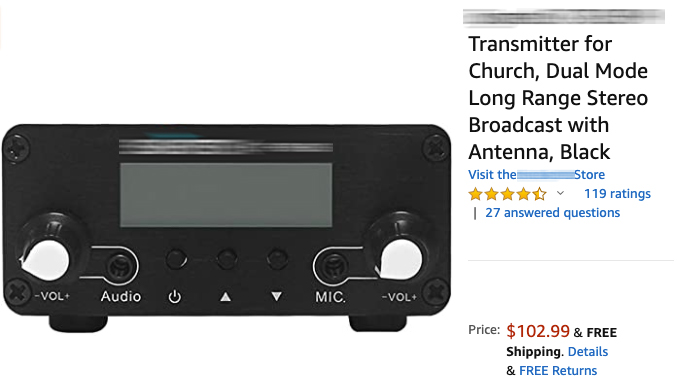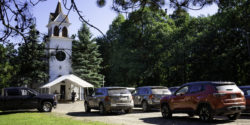It seems that social distancing has made unlicensed Part 15 radio a bit more popular. “Part 15” refers to the part of the US broadcast regulations that cover unintended transmissions and radio frequency interference. Essentially, this means tiny radio signals whose transmission can’t be avoided or are negligible. It also covers tiny radio transmitters, like the kind that fit into your cars 12-volt socket to broadcast your smartphone into your dashboard FM receiver, or, less commonly, AM transmitters used by real estate agents to create “talking houses” for drivers by.
With restrictions and good sense preventing many churches from holding in-person services, many apparently have looked to Part 15 broadcasting to transmit sermons to parishioners parked in their car. With a broadcast range of several hundred feet on the AM dial, it’s a way to bring people together for a shared experience while keeping them safely apart. All without requiring attendees to have smartphones or use up their mobile bandwidth (assuming a church is somewhere with reliable wireless coverage).
While a variety of Part 15 AM transmitters have been on the market for years, a new system actually calling itself “Parking Lot Radio” is in development right now. Suggesting uses for the system, the project’s website says,
In the current climate of Covid–19, the Parking Lot Radio allows churches to hold “drive-in” services. Other organizations can hold lectures, film screenings and other events, while maintaining social distancing.
While a few hundred feet or broadcast range is probably sufficient for a large percentage of worship houses, I can imagine it’s still not enough for some larger mega-churches, which might want to reach hundreds of cars in acres of parking lots.
It’s possible this limitation is behind a letter from Tennessee Rep. Mark Green, who wrote to FCC Chairman Ajit Pai asking for temporary waivers be issued to houses of worship for “long-range FM transmitters.” He specifically asked for the ability to “operate FM transmitters with an effective range greater than 200 feet.”
Careful with that FM Transmitter, Pastor
It’s notable that Rep. Green’s request was for FM transmitters, which are far more limited under Part 15. While the regulations for the AM dial put significant limits on transmitter power and antenna length, there’s no explicit limit on the signal distance. Clever and careful engineering can wring out a little more reach, and distances closer to a half-mile or more can be achieved.
But the FM band is regulated by a tight signal strength limit (250 uV/m) at 3 meters from the antenna, causing one engineer writing in Radio World to summarize the situation as, “[b]asically if you can hear them more than 250–300 feet from the site they’re not legal.”
Yet, a simple search for “FM Transmitter” on Amazon quickly turns up a product advertised as “Transmitter for Church, Dual Mode Long Range Stereo Broadcast with Antenna,” that promises, “[t]ransmission distance more than 300 meters (In the line of sight, field, open land).” It even promises, “FCC certified,” leading the average shopper to think they’d be ready to broadcast legally more than 900 feet away.

Don’t hit that “Buy Now” button yet.
Digging deeper into the product description we see the transmitter clearly listed as delivering “0.5W” which very like means a half-watt of power. Though it doesn’t sound like much compared to even LPFM’s 100 watt power limit, that’s still way too much.
Compare this to a truly legal and FCC certified Part 15 FM transmitter from the radio company C.Crane. The company states in the product’s FAQ that,
Most of our customers achieve 40 – 60 feet depending on their situation. The signal will travel up to 70’ under good conditions.
That’s less than a tenth the distance the Amazon until promises.
C.Crane doesn’t list their transmitter’s output, only specifying that it measures at “the maximum allowed by the FCC.” Though if we just look at the power consumption of 22.3mA and the fact that it runs on two AA batteries that provide three volts, then we can safely estimate it consumes less than a tenth of a watt. It most certainly transmits only a fraction of that.
What this means is that there is no way the Amazon half-watt transmitter is legal to use under Part 15 regulations, and the likelihood that it’s actually FCC certified is about a snowball’s chance in Hell. However, the fact that transmitters like these sell for about $100 and have the patina of legality probably means there are dozens, if not hundreds of churches and other well-meaning organizations using them all over the country. I wouldn’t be surprised if even just one of Rep. Green’s constituents has fired one up on Sundays, and maybe got tipped off that they could run afoul of the FCC.
The Challenge of Expanding FM Part 15
It’s not surprising that Chairman Pai recently denied Rep. Green’s request. In effect, he writes that the existing regulations are there for a reason, and that applications for licenses require proof that the proposed station would not interfere with existing ones.
I certainly would love to see a more robust legal unlicensed radio regime in US. Ideally it would be like New Zealand’s, which reserves a few frequencies for transmissions up to a one watt of power. I’d even settle for something tinier.
That said, I can actually empathize with the FCC on this one. The Part 15 rules are set under law; any changes would be difficult and slow. An attempt to provide waivers would result in howls of protest from the broadcast lobby, who are already in a tizzy about the rampant pirate operators in places like Brooklyn, Boston and South Florida.
I can also imagine the waivers would be challenging to enforce. Without a license to revoke, how would the FCC ever verify that anyone is keeping to the new limit, without basically further stepping up overtaxed field enforcement operations? Moreover, there aren’t commercially available FCC certified transmitters that would fit the bill. I doubt the Commission would want to tacitly authorize the currently-illicit transmitters that are all over online marketplaces.
Of course, a Sunday morning half-watt broadcast on an otherwise empty frequency in a small Tennessee town is unlikely to generate much harm, nor much attention. There are relatively few FCC field agents, and it’s hard to guess how many would enjoy spending their Sunday mornings cruising around looking for churches to bust. That doesn’t make it any more legal, and I’m not advising any law-abiding house of worship do this. I’m merely assessing the real-world risks.
Yet I would also agree that there’s a slippery slope from the well-meaning, conscientious and non-interfering broadcaster to the also well-meaning, but more loosey-goosey operator who decides to go for even more power, or to try squeezing their station onto a frequency that really isn’t that clear. On top of that, I understand that a lot of the transmitters you can get online put out a pretty dirty signal that cause additional interference by “splattering” onto adjacent frequencies. Using one responsibly is difficult or – as some would argue – impossible.
It takes knowledge, research and skill – and proper equipment – to broadcast cleanly above Part 15 limits without causing problems. So, caveat emptor.
Ultimately, this is why the Part 15 rules exist, even if some might argue that they’re too conservative and stringent.
Legal Unlicensed Part 15 Options Abound
That doesn’t mean churches, theaters or other organizations can’t leverage Part 15 broadcasting. As I mentioned earlier, there is a whole industry around manufacturing well-engineered and reliable transmitters, particularly for the AM band, where the achievable distances are greater. Despite the AM band’s diminished reputation, you can still get very good sound for voice and many kinds of music. Plus, the vast majority of cars still have AM receivers built in, which are also well optimized for the band.
Hobby Broadcaster should be the very first place you visit, where proprietor Bill DeFelice has done the hard work of testing and reviewing transmitters and writing guides for broadcasting legally and effectively without a license. We talked with Bill on episode #120 of our podcast, and I humbly suggest it’s a must-listen if you’re thinking at all of getting into Part 15 broadcasting.
Radio World also published a series of editorials and letters on Part 15 this summer, which might be of interest to the more technically minded.
Admittedly, the better FCC certified Part 15 AM transmitters are quite a bit more pricey than the sketchy FM ones on Amazon. You can expect to pay anywhere from $700 to $1000 for something like a Hamilton Rangemaster or ChezRadio Procaster.
But I’m also happy to report that the venerable Talking House transmitter – originally designed for real estate agents – can be had new for around $130. I own one of these that I use for my own tiny Part 15 broadcasts, transmitting experimental radio sounds to the surrounding neighborhood and passing cars. Using the stock antenna and very little optimization I can get the signal about a block away on a portable radio (that’s just 200 feet here in Portland, Oregon). In a car I’ve heard it faintly as much as four blocks away when the wind is blowing just right. That performance meets my expectations, and it sounds just fine for what I’m doing.
We at Radio Survivor love a tiny radio station. We’ve written and podcasted about the topic many, many times. If your interest is piqued, dig into the world of Part 15 with us:
- LA’s KCHUNG Radio Demonstrates the Power of Part 15 Broadcasting
- Radio Station Visit #117 – KCHUNG Radio in Los Angeles
- Podcast #74 – Station or Static? KCHUNG Is L.A.’s Underground Radio
- Podcast #51 – Carrier Current is Cool
- A Middle Ground Between Unlicensed Micropower & LPFM?
- Reviving the southwest with community radio
- Pacifica’s KPFK to try unlicensed radio
P.S. I wanted to note that while Part 15 FM radio is limited compared to the AM band, if you prefer to try the FM band there are a number of fully-legal and FCC certified transmitters out there. Beyond the consumer-grade C.Crane model mentioned above, Progressive Concepts has been building and selling sturdy pro-grade transmitters for a couple of decades. Their ACC100 models promise a 200 foot radius transmission distance, which pretty much the most you can expect while staying legal.
Photo credit: Lorie Shaull / flickr (CC BY-NC-ND 2.0)



